Comprehensive Cost Management, Budgeting, and Variance Analysis
VerifiedAdded on 2022/02/28
|21
|5338
|123
Report
AI Summary
This report delves into the critical aspects of cost management, essential for organizational decision-making and profit maximization. It begins with a thorough classification of costs, distinguishing between direct and indirect costs, and explores various costing methods such as job order, process, batch, contract, and service costing, including hybrid approaches. The report then delves into the calculation of costs using FIFO, LIFO, and weighted average methods. A significant portion is dedicated to preparing and analyzing cost reports, identifying variances, and commenting on performance, including the use of performance indicators. Furthermore, the report examines the purpose and nature of budgeting, appropriate budgeting methods like incremental and zero-based budgeting, and the preparation of production, purchase, and cash budgets. It concludes with variance calculations, identifying potential causes for variances, and recommendations for corrective actions, along with a reconciliation of budgeted and actual results, culminating in reports to management.
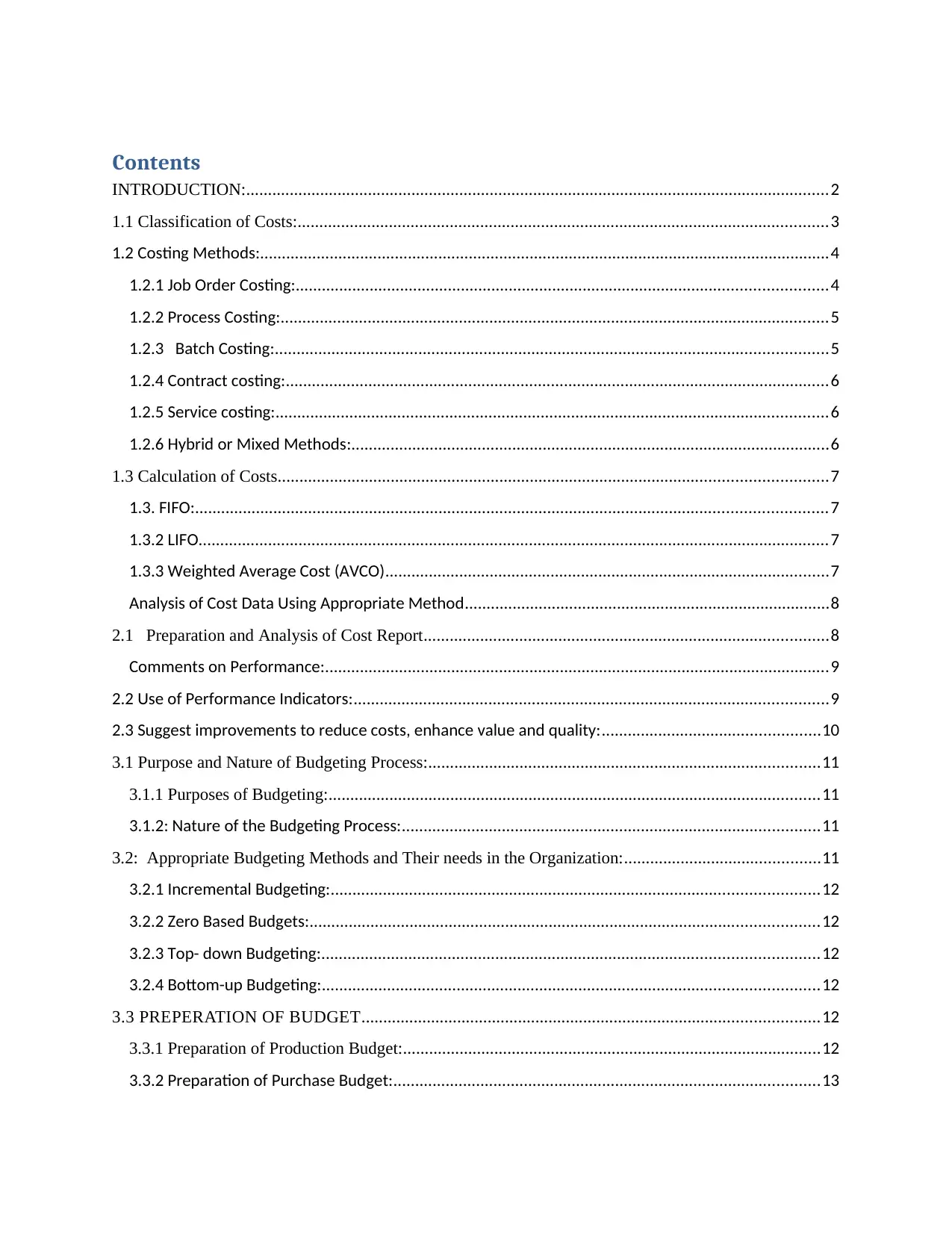
Contents
INTRODUCTION:......................................................................................................................................2
1.1 Classification of Costs:..........................................................................................................................3
1.2 Costing Methods:...................................................................................................................................4
1.2.1 Job Order Costing:..........................................................................................................................4
1.2.2 Process Costing:..............................................................................................................................5
1.2.3 Batch Costing:...............................................................................................................................5
1.2.4 Contract costing:.............................................................................................................................6
1.2.5 Service costing:...............................................................................................................................6
1.2.6 Hybrid or Mixed Methods:..............................................................................................................6
1.3 Calculation of Costs..............................................................................................................................7
1.3. FIFO:.................................................................................................................................................7
1.3.2 LIFO.................................................................................................................................................7
1.3.3 Weighted Average Cost (AVCO)......................................................................................................7
Analysis of Cost Data Using Appropriate Method....................................................................................8
2.1 Preparation and Analysis of Cost Report.............................................................................................8
Comments on Performance:....................................................................................................................9
2.2 Use of Performance Indicators:.............................................................................................................9
2.3 Suggest improvements to reduce costs, enhance value and quality:..................................................10
3.1 Purpose and Nature of Budgeting Process:..........................................................................................11
3.1.1 Purposes of Budgeting:.................................................................................................................11
3.1.2: Nature of the Budgeting Process:................................................................................................11
3.2: Appropriate Budgeting Methods and Their needs in the Organization:.............................................11
3.2.1 Incremental Budgeting:................................................................................................................12
3.2.2 Zero Based Budgets:.....................................................................................................................12
3.2.3 Top- down Budgeting:..................................................................................................................12
3.2.4 Bottom-up Budgeting:..................................................................................................................12
3.3 PREPERATION OF BUDGET.........................................................................................................12
3.3.1 Preparation of Production Budget:................................................................................................12
3.3.2 Preparation of Purchase Budget:..................................................................................................13
INTRODUCTION:......................................................................................................................................2
1.1 Classification of Costs:..........................................................................................................................3
1.2 Costing Methods:...................................................................................................................................4
1.2.1 Job Order Costing:..........................................................................................................................4
1.2.2 Process Costing:..............................................................................................................................5
1.2.3 Batch Costing:...............................................................................................................................5
1.2.4 Contract costing:.............................................................................................................................6
1.2.5 Service costing:...............................................................................................................................6
1.2.6 Hybrid or Mixed Methods:..............................................................................................................6
1.3 Calculation of Costs..............................................................................................................................7
1.3. FIFO:.................................................................................................................................................7
1.3.2 LIFO.................................................................................................................................................7
1.3.3 Weighted Average Cost (AVCO)......................................................................................................7
Analysis of Cost Data Using Appropriate Method....................................................................................8
2.1 Preparation and Analysis of Cost Report.............................................................................................8
Comments on Performance:....................................................................................................................9
2.2 Use of Performance Indicators:.............................................................................................................9
2.3 Suggest improvements to reduce costs, enhance value and quality:..................................................10
3.1 Purpose and Nature of Budgeting Process:..........................................................................................11
3.1.1 Purposes of Budgeting:.................................................................................................................11
3.1.2: Nature of the Budgeting Process:................................................................................................11
3.2: Appropriate Budgeting Methods and Their needs in the Organization:.............................................11
3.2.1 Incremental Budgeting:................................................................................................................12
3.2.2 Zero Based Budgets:.....................................................................................................................12
3.2.3 Top- down Budgeting:..................................................................................................................12
3.2.4 Bottom-up Budgeting:..................................................................................................................12
3.3 PREPERATION OF BUDGET.........................................................................................................12
3.3.1 Preparation of Production Budget:................................................................................................12
3.3.2 Preparation of Purchase Budget:..................................................................................................13
Paraphrase This Document
Need a fresh take? Get an instant paraphrase of this document with our AI Paraphraser
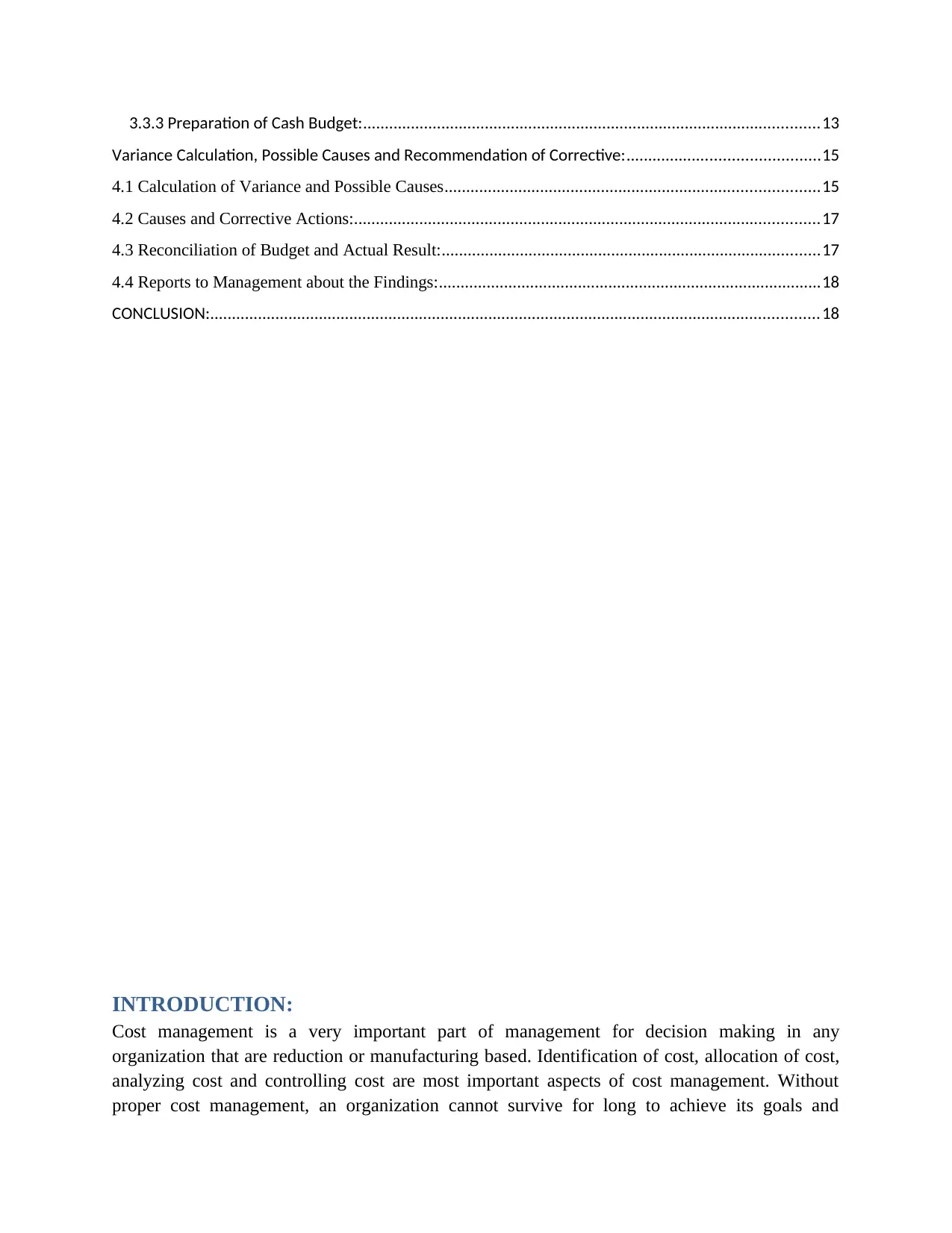
3.3.3 Preparation of Cash Budget:.........................................................................................................13
Variance Calculation, Possible Causes and Recommendation of Corrective:............................................15
4.1 Calculation of Variance and Possible Causes......................................................................................15
4.2 Causes and Corrective Actions:...........................................................................................................17
4.3 Reconciliation of Budget and Actual Result:.......................................................................................17
4.4 Reports to Management about the Findings:........................................................................................18
CONCLUSION:............................................................................................................................................18
INTRODUCTION:
Cost management is a very important part of management for decision making in any
organization that are reduction or manufacturing based. Identification of cost, allocation of cost,
analyzing cost and controlling cost are most important aspects of cost management. Without
proper cost management, an organization cannot survive for long to achieve its goals and
Variance Calculation, Possible Causes and Recommendation of Corrective:............................................15
4.1 Calculation of Variance and Possible Causes......................................................................................15
4.2 Causes and Corrective Actions:...........................................................................................................17
4.3 Reconciliation of Budget and Actual Result:.......................................................................................17
4.4 Reports to Management about the Findings:........................................................................................18
CONCLUSION:............................................................................................................................................18
INTRODUCTION:
Cost management is a very important part of management for decision making in any
organization that are reduction or manufacturing based. Identification of cost, allocation of cost,
analyzing cost and controlling cost are most important aspects of cost management. Without
proper cost management, an organization cannot survive for long to achieve its goals and
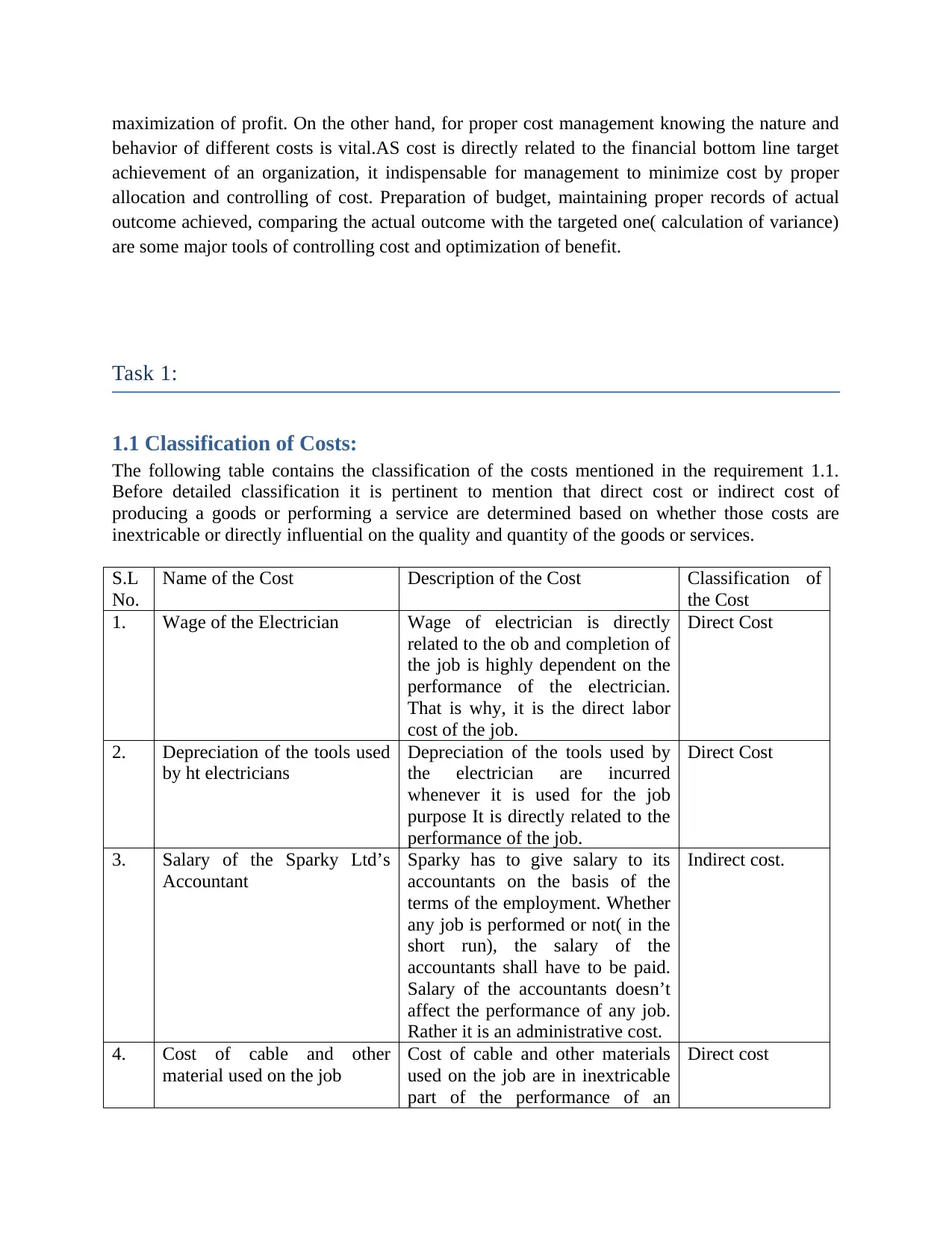
maximization of profit. On the other hand, for proper cost management knowing the nature and
behavior of different costs is vital.AS cost is directly related to the financial bottom line target
achievement of an organization, it indispensable for management to minimize cost by proper
allocation and controlling of cost. Preparation of budget, maintaining proper records of actual
outcome achieved, comparing the actual outcome with the targeted one( calculation of variance)
are some major tools of controlling cost and optimization of benefit.
Task 1:
1.1 Classification of Costs:
The following table contains the classification of the costs mentioned in the requirement 1.1.
Before detailed classification it is pertinent to mention that direct cost or indirect cost of
producing a goods or performing a service are determined based on whether those costs are
inextricable or directly influential on the quality and quantity of the goods or services.
S.L
No.
Name of the Cost Description of the Cost Classification of
the Cost
1. Wage of the Electrician Wage of electrician is directly
related to the ob and completion of
the job is highly dependent on the
performance of the electrician.
That is why, it is the direct labor
cost of the job.
Direct Cost
2. Depreciation of the tools used
by ht electricians
Depreciation of the tools used by
the electrician are incurred
whenever it is used for the job
purpose It is directly related to the
performance of the job.
Direct Cost
3. Salary of the Sparky Ltd’s
Accountant
Sparky has to give salary to its
accountants on the basis of the
terms of the employment. Whether
any job is performed or not( in the
short run), the salary of the
accountants shall have to be paid.
Salary of the accountants doesn’t
affect the performance of any job.
Rather it is an administrative cost.
Indirect cost.
4. Cost of cable and other
material used on the job
Cost of cable and other materials
used on the job are in inextricable
part of the performance of an
Direct cost
behavior of different costs is vital.AS cost is directly related to the financial bottom line target
achievement of an organization, it indispensable for management to minimize cost by proper
allocation and controlling of cost. Preparation of budget, maintaining proper records of actual
outcome achieved, comparing the actual outcome with the targeted one( calculation of variance)
are some major tools of controlling cost and optimization of benefit.
Task 1:
1.1 Classification of Costs:
The following table contains the classification of the costs mentioned in the requirement 1.1.
Before detailed classification it is pertinent to mention that direct cost or indirect cost of
producing a goods or performing a service are determined based on whether those costs are
inextricable or directly influential on the quality and quantity of the goods or services.
S.L
No.
Name of the Cost Description of the Cost Classification of
the Cost
1. Wage of the Electrician Wage of electrician is directly
related to the ob and completion of
the job is highly dependent on the
performance of the electrician.
That is why, it is the direct labor
cost of the job.
Direct Cost
2. Depreciation of the tools used
by ht electricians
Depreciation of the tools used by
the electrician are incurred
whenever it is used for the job
purpose It is directly related to the
performance of the job.
Direct Cost
3. Salary of the Sparky Ltd’s
Accountant
Sparky has to give salary to its
accountants on the basis of the
terms of the employment. Whether
any job is performed or not( in the
short run), the salary of the
accountants shall have to be paid.
Salary of the accountants doesn’t
affect the performance of any job.
Rather it is an administrative cost.
Indirect cost.
4. Cost of cable and other
material used on the job
Cost of cable and other materials
used on the job are in inextricable
part of the performance of an
Direct cost
⊘ This is a preview!⊘
Do you want full access?
Subscribe today to unlock all pages.

Trusted by 1+ million students worldwide
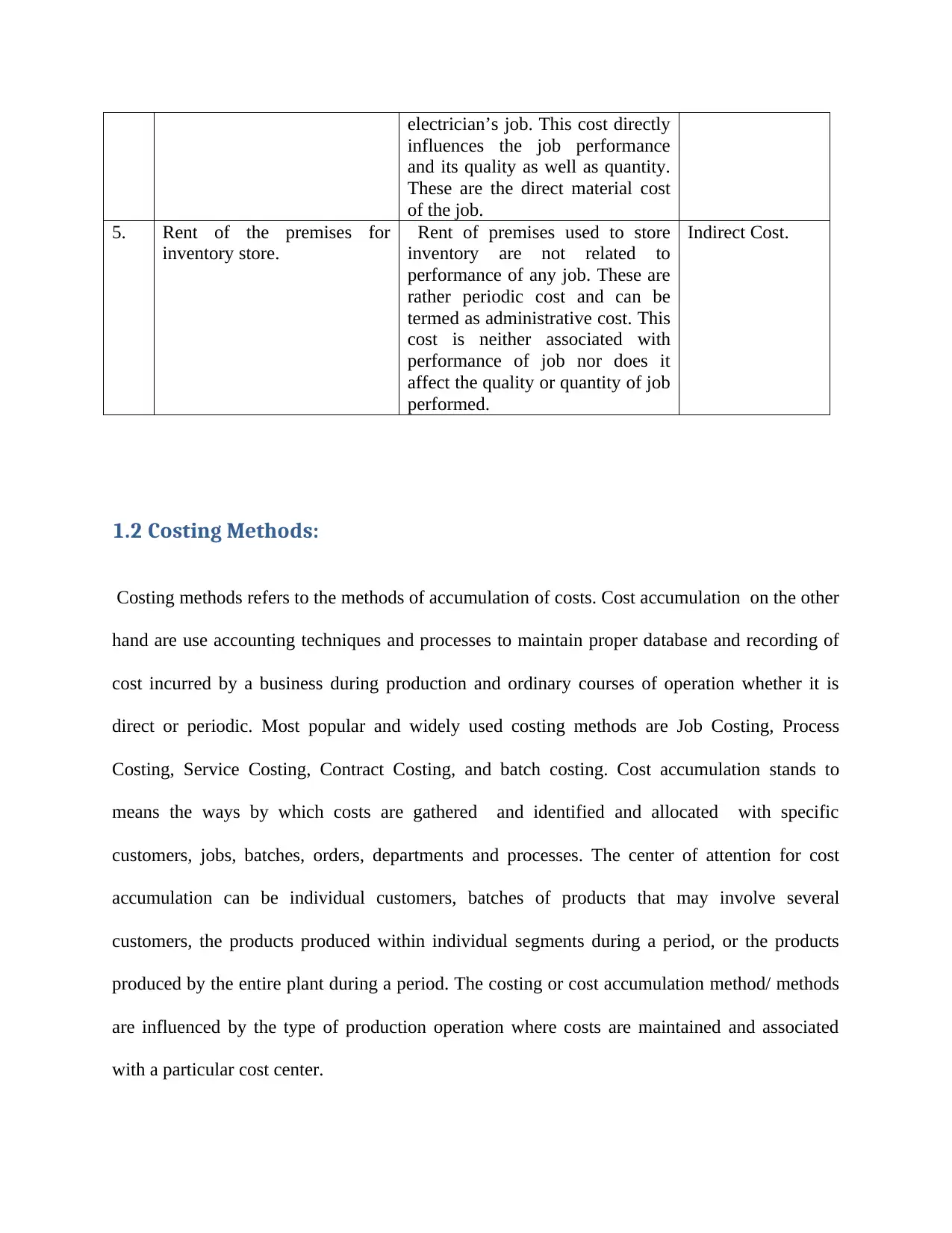
electrician’s job. This cost directly
influences the job performance
and its quality as well as quantity.
These are the direct material cost
of the job.
5. Rent of the premises for
inventory store.
Rent of premises used to store
inventory are not related to
performance of any job. These are
rather periodic cost and can be
termed as administrative cost. This
cost is neither associated with
performance of job nor does it
affect the quality or quantity of job
performed.
Indirect Cost.
1.2 Costing Methods:
Costing methods refers to the methods of accumulation of costs. Cost accumulation on the other
hand are use accounting techniques and processes to maintain proper database and recording of
cost incurred by a business during production and ordinary courses of operation whether it is
direct or periodic. Most popular and widely used costing methods are Job Costing, Process
Costing, Service Costing, Contract Costing, and batch costing. Cost accumulation stands to
means the ways by which costs are gathered and identified and allocated with specific
customers, jobs, batches, orders, departments and processes. The center of attention for cost
accumulation can be individual customers, batches of products that may involve several
customers, the products produced within individual segments during a period, or the products
produced by the entire plant during a period. The costing or cost accumulation method/ methods
are influenced by the type of production operation where costs are maintained and associated
with a particular cost center.
influences the job performance
and its quality as well as quantity.
These are the direct material cost
of the job.
5. Rent of the premises for
inventory store.
Rent of premises used to store
inventory are not related to
performance of any job. These are
rather periodic cost and can be
termed as administrative cost. This
cost is neither associated with
performance of job nor does it
affect the quality or quantity of job
performed.
Indirect Cost.
1.2 Costing Methods:
Costing methods refers to the methods of accumulation of costs. Cost accumulation on the other
hand are use accounting techniques and processes to maintain proper database and recording of
cost incurred by a business during production and ordinary courses of operation whether it is
direct or periodic. Most popular and widely used costing methods are Job Costing, Process
Costing, Service Costing, Contract Costing, and batch costing. Cost accumulation stands to
means the ways by which costs are gathered and identified and allocated with specific
customers, jobs, batches, orders, departments and processes. The center of attention for cost
accumulation can be individual customers, batches of products that may involve several
customers, the products produced within individual segments during a period, or the products
produced by the entire plant during a period. The costing or cost accumulation method/ methods
are influenced by the type of production operation where costs are maintained and associated
with a particular cost center.
Paraphrase This Document
Need a fresh take? Get an instant paraphrase of this document with our AI Paraphraser
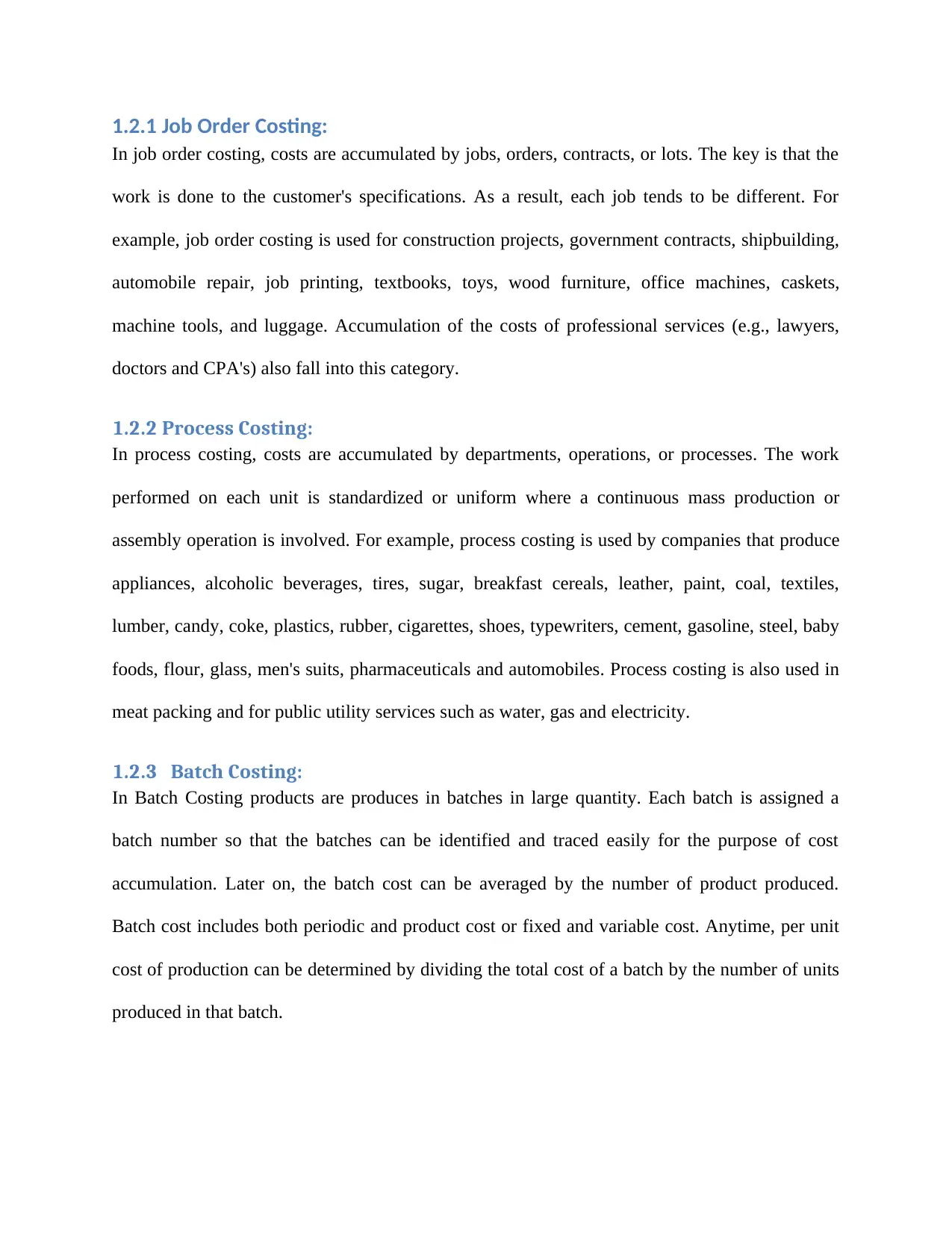
1.2.1 Job Order Costing:
In job order costing, costs are accumulated by jobs, orders, contracts, or lots. The key is that the
work is done to the customer's specifications. As a result, each job tends to be different. For
example, job order costing is used for construction projects, government contracts, shipbuilding,
automobile repair, job printing, textbooks, toys, wood furniture, office machines, caskets,
machine tools, and luggage. Accumulation of the costs of professional services (e.g., lawyers,
doctors and CPA's) also fall into this category.
1.2.2 Process Costing:
In process costing, costs are accumulated by departments, operations, or processes. The work
performed on each unit is standardized or uniform where a continuous mass production or
assembly operation is involved. For example, process costing is used by companies that produce
appliances, alcoholic beverages, tires, sugar, breakfast cereals, leather, paint, coal, textiles,
lumber, candy, coke, plastics, rubber, cigarettes, shoes, typewriters, cement, gasoline, steel, baby
foods, flour, glass, men's suits, pharmaceuticals and automobiles. Process costing is also used in
meat packing and for public utility services such as water, gas and electricity.
1.2.3 Batch Costing:
In Batch Costing products are produces in batches in large quantity. Each batch is assigned a
batch number so that the batches can be identified and traced easily for the purpose of cost
accumulation. Later on, the batch cost can be averaged by the number of product produced.
Batch cost includes both periodic and product cost or fixed and variable cost. Anytime, per unit
cost of production can be determined by dividing the total cost of a batch by the number of units
produced in that batch.
In job order costing, costs are accumulated by jobs, orders, contracts, or lots. The key is that the
work is done to the customer's specifications. As a result, each job tends to be different. For
example, job order costing is used for construction projects, government contracts, shipbuilding,
automobile repair, job printing, textbooks, toys, wood furniture, office machines, caskets,
machine tools, and luggage. Accumulation of the costs of professional services (e.g., lawyers,
doctors and CPA's) also fall into this category.
1.2.2 Process Costing:
In process costing, costs are accumulated by departments, operations, or processes. The work
performed on each unit is standardized or uniform where a continuous mass production or
assembly operation is involved. For example, process costing is used by companies that produce
appliances, alcoholic beverages, tires, sugar, breakfast cereals, leather, paint, coal, textiles,
lumber, candy, coke, plastics, rubber, cigarettes, shoes, typewriters, cement, gasoline, steel, baby
foods, flour, glass, men's suits, pharmaceuticals and automobiles. Process costing is also used in
meat packing and for public utility services such as water, gas and electricity.
1.2.3 Batch Costing:
In Batch Costing products are produces in batches in large quantity. Each batch is assigned a
batch number so that the batches can be identified and traced easily for the purpose of cost
accumulation. Later on, the batch cost can be averaged by the number of product produced.
Batch cost includes both periodic and product cost or fixed and variable cost. Anytime, per unit
cost of production can be determined by dividing the total cost of a batch by the number of units
produced in that batch.
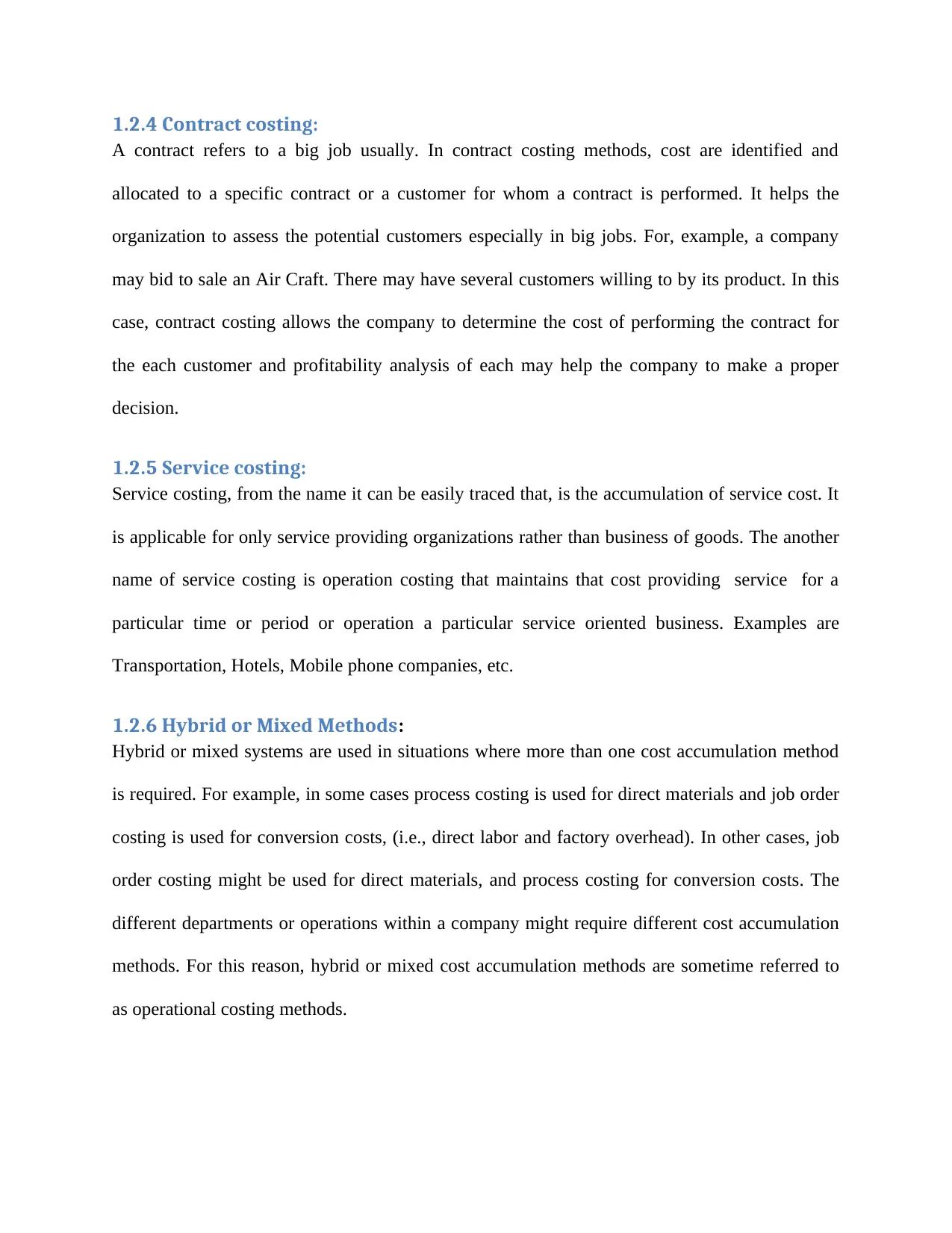
1.2.4 Contract costing:
A contract refers to a big job usually. In contract costing methods, cost are identified and
allocated to a specific contract or a customer for whom a contract is performed. It helps the
organization to assess the potential customers especially in big jobs. For, example, a company
may bid to sale an Air Craft. There may have several customers willing to by its product. In this
case, contract costing allows the company to determine the cost of performing the contract for
the each customer and profitability analysis of each may help the company to make a proper
decision.
1.2.5 Service costing:
Service costing, from the name it can be easily traced that, is the accumulation of service cost. It
is applicable for only service providing organizations rather than business of goods. The another
name of service costing is operation costing that maintains that cost providing service for a
particular time or period or operation a particular service oriented business. Examples are
Transportation, Hotels, Mobile phone companies, etc.
1.2.6 Hybrid or Mixed Methods:
Hybrid or mixed systems are used in situations where more than one cost accumulation method
is required. For example, in some cases process costing is used for direct materials and job order
costing is used for conversion costs, (i.e., direct labor and factory overhead). In other cases, job
order costing might be used for direct materials, and process costing for conversion costs. The
different departments or operations within a company might require different cost accumulation
methods. For this reason, hybrid or mixed cost accumulation methods are sometime referred to
as operational costing methods.
A contract refers to a big job usually. In contract costing methods, cost are identified and
allocated to a specific contract or a customer for whom a contract is performed. It helps the
organization to assess the potential customers especially in big jobs. For, example, a company
may bid to sale an Air Craft. There may have several customers willing to by its product. In this
case, contract costing allows the company to determine the cost of performing the contract for
the each customer and profitability analysis of each may help the company to make a proper
decision.
1.2.5 Service costing:
Service costing, from the name it can be easily traced that, is the accumulation of service cost. It
is applicable for only service providing organizations rather than business of goods. The another
name of service costing is operation costing that maintains that cost providing service for a
particular time or period or operation a particular service oriented business. Examples are
Transportation, Hotels, Mobile phone companies, etc.
1.2.6 Hybrid or Mixed Methods:
Hybrid or mixed systems are used in situations where more than one cost accumulation method
is required. For example, in some cases process costing is used for direct materials and job order
costing is used for conversion costs, (i.e., direct labor and factory overhead). In other cases, job
order costing might be used for direct materials, and process costing for conversion costs. The
different departments or operations within a company might require different cost accumulation
methods. For this reason, hybrid or mixed cost accumulation methods are sometime referred to
as operational costing methods.
⊘ This is a preview!⊘
Do you want full access?
Subscribe today to unlock all pages.

Trusted by 1+ million students worldwide
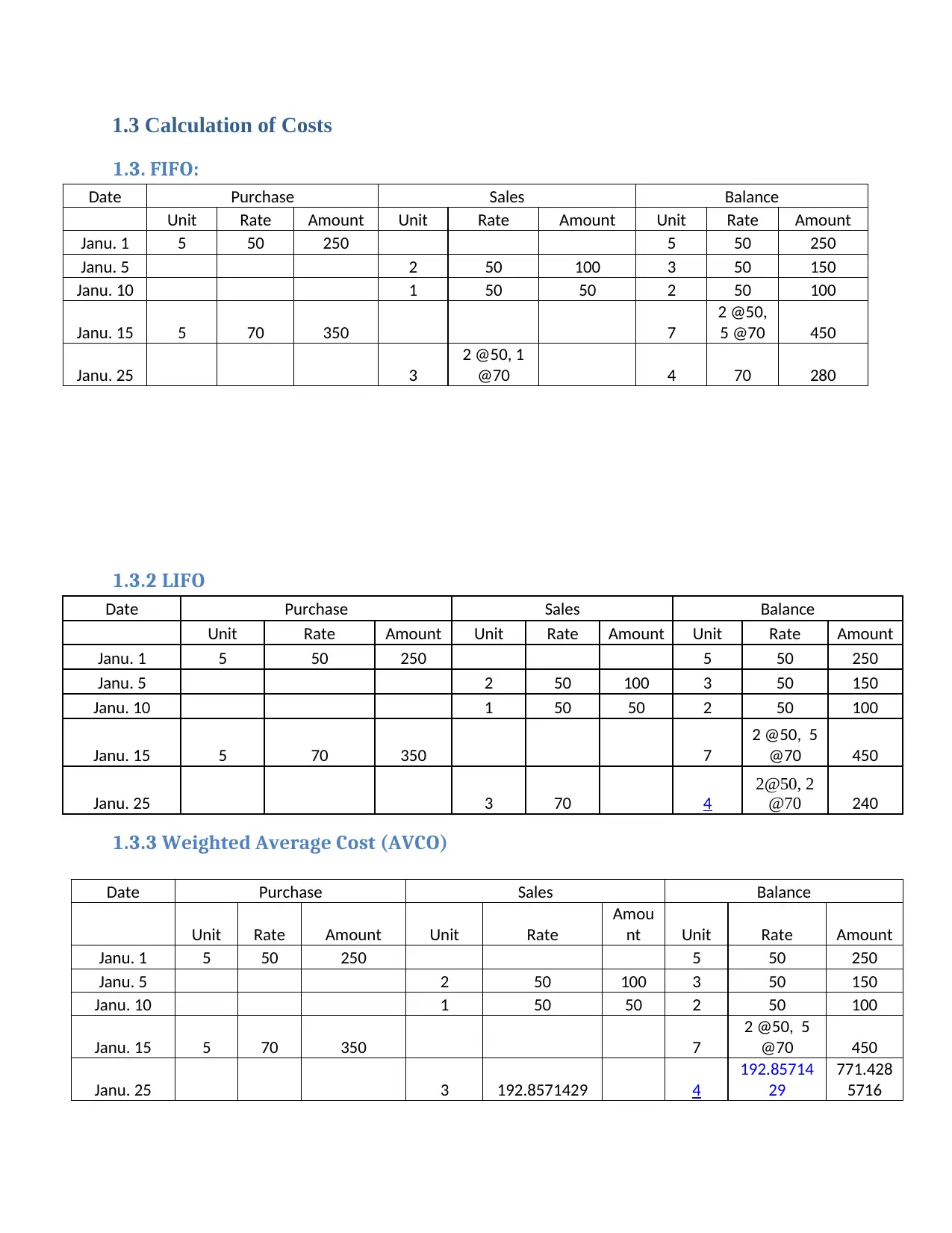
1.3 Calculation of Costs
1.3. FIFO:
Date Purchase Sales Balance
Unit Rate Amount Unit Rate Amount Unit Rate Amount
Janu. 1 5 50 250 5 50 250
Janu. 5 2 50 100 3 50 150
Janu. 10 1 50 50 2 50 100
Janu. 15 5 70 350 7
2 @50,
5 @70 450
Janu. 25 3
2 @50, 1
@70 4 70 280
1.3.2 LIFO
Date Purchase Sales Balance
Unit Rate Amount Unit Rate Amount Unit Rate Amount
Janu. 1 5 50 250 5 50 250
Janu. 5 2 50 100 3 50 150
Janu. 10 1 50 50 2 50 100
Janu. 15 5 70 350 7
2 @50, 5
@70 450
Janu. 25 3 70 4
2@50, 2
@70 240
1.3.3 Weighted Average Cost (AVCO)
Date Purchase Sales Balance
Unit Rate Amount Unit Rate
Amou
nt Unit Rate Amount
Janu. 1 5 50 250 5 50 250
Janu. 5 2 50 100 3 50 150
Janu. 10 1 50 50 2 50 100
Janu. 15 5 70 350 7
2 @50, 5
@70 450
Janu. 25 3 192.8571429 4
192.85714
29
771.428
5716
1.3. FIFO:
Date Purchase Sales Balance
Unit Rate Amount Unit Rate Amount Unit Rate Amount
Janu. 1 5 50 250 5 50 250
Janu. 5 2 50 100 3 50 150
Janu. 10 1 50 50 2 50 100
Janu. 15 5 70 350 7
2 @50,
5 @70 450
Janu. 25 3
2 @50, 1
@70 4 70 280
1.3.2 LIFO
Date Purchase Sales Balance
Unit Rate Amount Unit Rate Amount Unit Rate Amount
Janu. 1 5 50 250 5 50 250
Janu. 5 2 50 100 3 50 150
Janu. 10 1 50 50 2 50 100
Janu. 15 5 70 350 7
2 @50, 5
@70 450
Janu. 25 3 70 4
2@50, 2
@70 240
1.3.3 Weighted Average Cost (AVCO)
Date Purchase Sales Balance
Unit Rate Amount Unit Rate
Amou
nt Unit Rate Amount
Janu. 1 5 50 250 5 50 250
Janu. 5 2 50 100 3 50 150
Janu. 10 1 50 50 2 50 100
Janu. 15 5 70 350 7
2 @50, 5
@70 450
Janu. 25 3 192.8571429 4
192.85714
29
771.428
5716
Paraphrase This Document
Need a fresh take? Get an instant paraphrase of this document with our AI Paraphraser
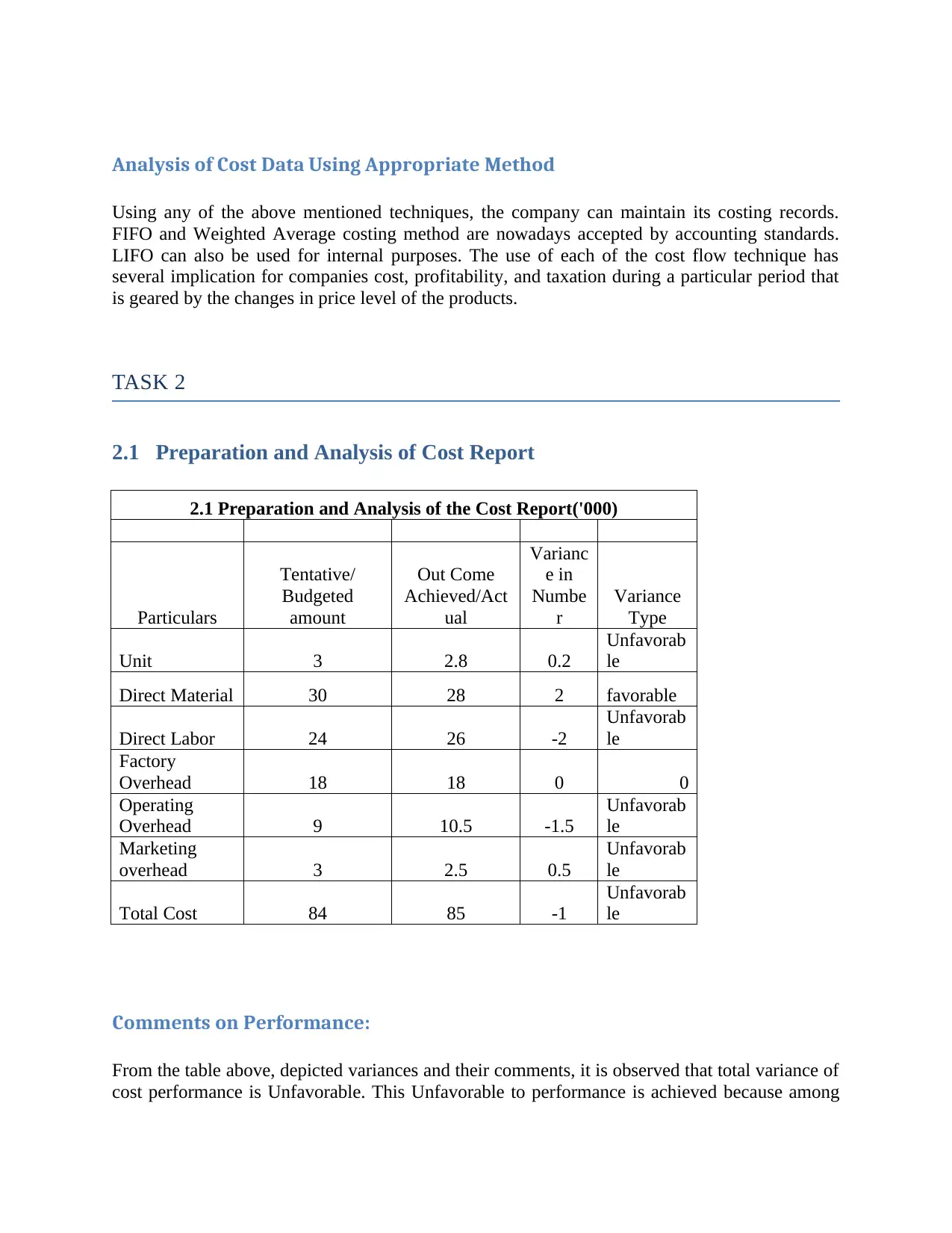
Analysis of Cost Data Using Appropriate Method
Using any of the above mentioned techniques, the company can maintain its costing records.
FIFO and Weighted Average costing method are nowadays accepted by accounting standards.
LIFO can also be used for internal purposes. The use of each of the cost flow technique has
several implication for companies cost, profitability, and taxation during a particular period that
is geared by the changes in price level of the products.
TASK 2
2.1 Preparation and Analysis of Cost Report
2.1 Preparation and Analysis of the Cost Report('000)
Particulars
Tentative/
Budgeted
amount
Out Come
Achieved/Act
ual
Varianc
e in
Numbe
r
Variance
Type
Unit 3 2.8 0.2
Unfavorab
le
Direct Material 30 28 2 favorable
Direct Labor 24 26 -2
Unfavorab
le
Factory
Overhead 18 18 0 0
Operating
Overhead 9 10.5 -1.5
Unfavorab
le
Marketing
overhead 3 2.5 0.5
Unfavorab
le
Total Cost 84 85 -1
Unfavorab
le
Comments on Performance:
From the table above, depicted variances and their comments, it is observed that total variance of
cost performance is Unfavorable. This Unfavorable to performance is achieved because among
Using any of the above mentioned techniques, the company can maintain its costing records.
FIFO and Weighted Average costing method are nowadays accepted by accounting standards.
LIFO can also be used for internal purposes. The use of each of the cost flow technique has
several implication for companies cost, profitability, and taxation during a particular period that
is geared by the changes in price level of the products.
TASK 2
2.1 Preparation and Analysis of Cost Report
2.1 Preparation and Analysis of the Cost Report('000)
Particulars
Tentative/
Budgeted
amount
Out Come
Achieved/Act
ual
Varianc
e in
Numbe
r
Variance
Type
Unit 3 2.8 0.2
Unfavorab
le
Direct Material 30 28 2 favorable
Direct Labor 24 26 -2
Unfavorab
le
Factory
Overhead 18 18 0 0
Operating
Overhead 9 10.5 -1.5
Unfavorab
le
Marketing
overhead 3 2.5 0.5
Unfavorab
le
Total Cost 84 85 -1
Unfavorab
le
Comments on Performance:
From the table above, depicted variances and their comments, it is observed that total variance of
cost performance is Unfavorable. This Unfavorable to performance is achieved because among
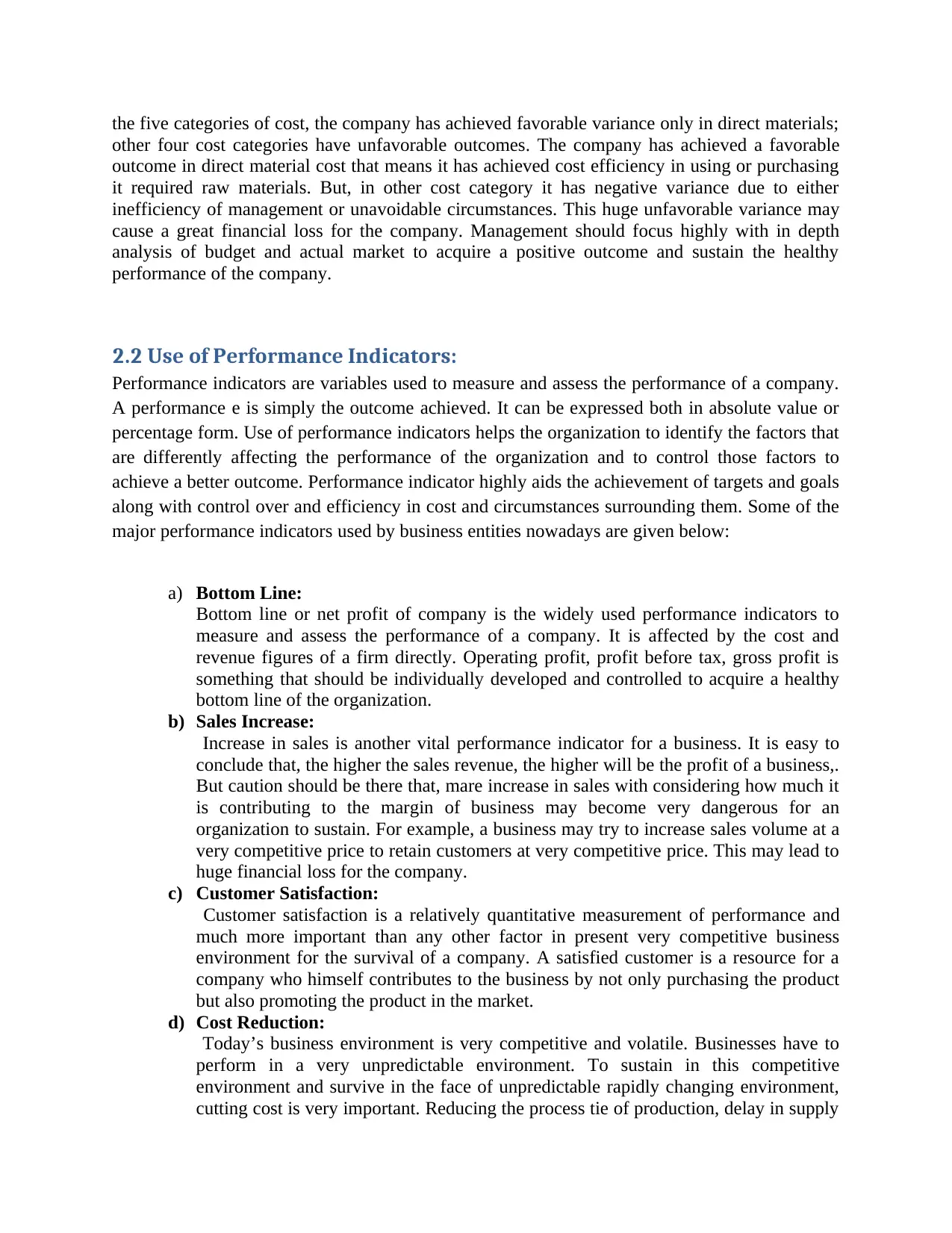
the five categories of cost, the company has achieved favorable variance only in direct materials;
other four cost categories have unfavorable outcomes. The company has achieved a favorable
outcome in direct material cost that means it has achieved cost efficiency in using or purchasing
it required raw materials. But, in other cost category it has negative variance due to either
inefficiency of management or unavoidable circumstances. This huge unfavorable variance may
cause a great financial loss for the company. Management should focus highly with in depth
analysis of budget and actual market to acquire a positive outcome and sustain the healthy
performance of the company.
2.2 Use of Performance Indicators:
Performance indicators are variables used to measure and assess the performance of a company.
A performance e is simply the outcome achieved. It can be expressed both in absolute value or
percentage form. Use of performance indicators helps the organization to identify the factors that
are differently affecting the performance of the organization and to control those factors to
achieve a better outcome. Performance indicator highly aids the achievement of targets and goals
along with control over and efficiency in cost and circumstances surrounding them. Some of the
major performance indicators used by business entities nowadays are given below:
a) Bottom Line:
Bottom line or net profit of company is the widely used performance indicators to
measure and assess the performance of a company. It is affected by the cost and
revenue figures of a firm directly. Operating profit, profit before tax, gross profit is
something that should be individually developed and controlled to acquire a healthy
bottom line of the organization.
b) Sales Increase:
Increase in sales is another vital performance indicator for a business. It is easy to
conclude that, the higher the sales revenue, the higher will be the profit of a business,.
But caution should be there that, mare increase in sales with considering how much it
is contributing to the margin of business may become very dangerous for an
organization to sustain. For example, a business may try to increase sales volume at a
very competitive price to retain customers at very competitive price. This may lead to
huge financial loss for the company.
c) Customer Satisfaction:
Customer satisfaction is a relatively quantitative measurement of performance and
much more important than any other factor in present very competitive business
environment for the survival of a company. A satisfied customer is a resource for a
company who himself contributes to the business by not only purchasing the product
but also promoting the product in the market.
d) Cost Reduction:
Today’s business environment is very competitive and volatile. Businesses have to
perform in a very unpredictable environment. To sustain in this competitive
environment and survive in the face of unpredictable rapidly changing environment,
cutting cost is very important. Reducing the process tie of production, delay in supply
other four cost categories have unfavorable outcomes. The company has achieved a favorable
outcome in direct material cost that means it has achieved cost efficiency in using or purchasing
it required raw materials. But, in other cost category it has negative variance due to either
inefficiency of management or unavoidable circumstances. This huge unfavorable variance may
cause a great financial loss for the company. Management should focus highly with in depth
analysis of budget and actual market to acquire a positive outcome and sustain the healthy
performance of the company.
2.2 Use of Performance Indicators:
Performance indicators are variables used to measure and assess the performance of a company.
A performance e is simply the outcome achieved. It can be expressed both in absolute value or
percentage form. Use of performance indicators helps the organization to identify the factors that
are differently affecting the performance of the organization and to control those factors to
achieve a better outcome. Performance indicator highly aids the achievement of targets and goals
along with control over and efficiency in cost and circumstances surrounding them. Some of the
major performance indicators used by business entities nowadays are given below:
a) Bottom Line:
Bottom line or net profit of company is the widely used performance indicators to
measure and assess the performance of a company. It is affected by the cost and
revenue figures of a firm directly. Operating profit, profit before tax, gross profit is
something that should be individually developed and controlled to acquire a healthy
bottom line of the organization.
b) Sales Increase:
Increase in sales is another vital performance indicator for a business. It is easy to
conclude that, the higher the sales revenue, the higher will be the profit of a business,.
But caution should be there that, mare increase in sales with considering how much it
is contributing to the margin of business may become very dangerous for an
organization to sustain. For example, a business may try to increase sales volume at a
very competitive price to retain customers at very competitive price. This may lead to
huge financial loss for the company.
c) Customer Satisfaction:
Customer satisfaction is a relatively quantitative measurement of performance and
much more important than any other factor in present very competitive business
environment for the survival of a company. A satisfied customer is a resource for a
company who himself contributes to the business by not only purchasing the product
but also promoting the product in the market.
d) Cost Reduction:
Today’s business environment is very competitive and volatile. Businesses have to
perform in a very unpredictable environment. To sustain in this competitive
environment and survive in the face of unpredictable rapidly changing environment,
cutting cost is very important. Reducing the process tie of production, delay in supply
⊘ This is a preview!⊘
Do you want full access?
Subscribe today to unlock all pages.

Trusted by 1+ million students worldwide
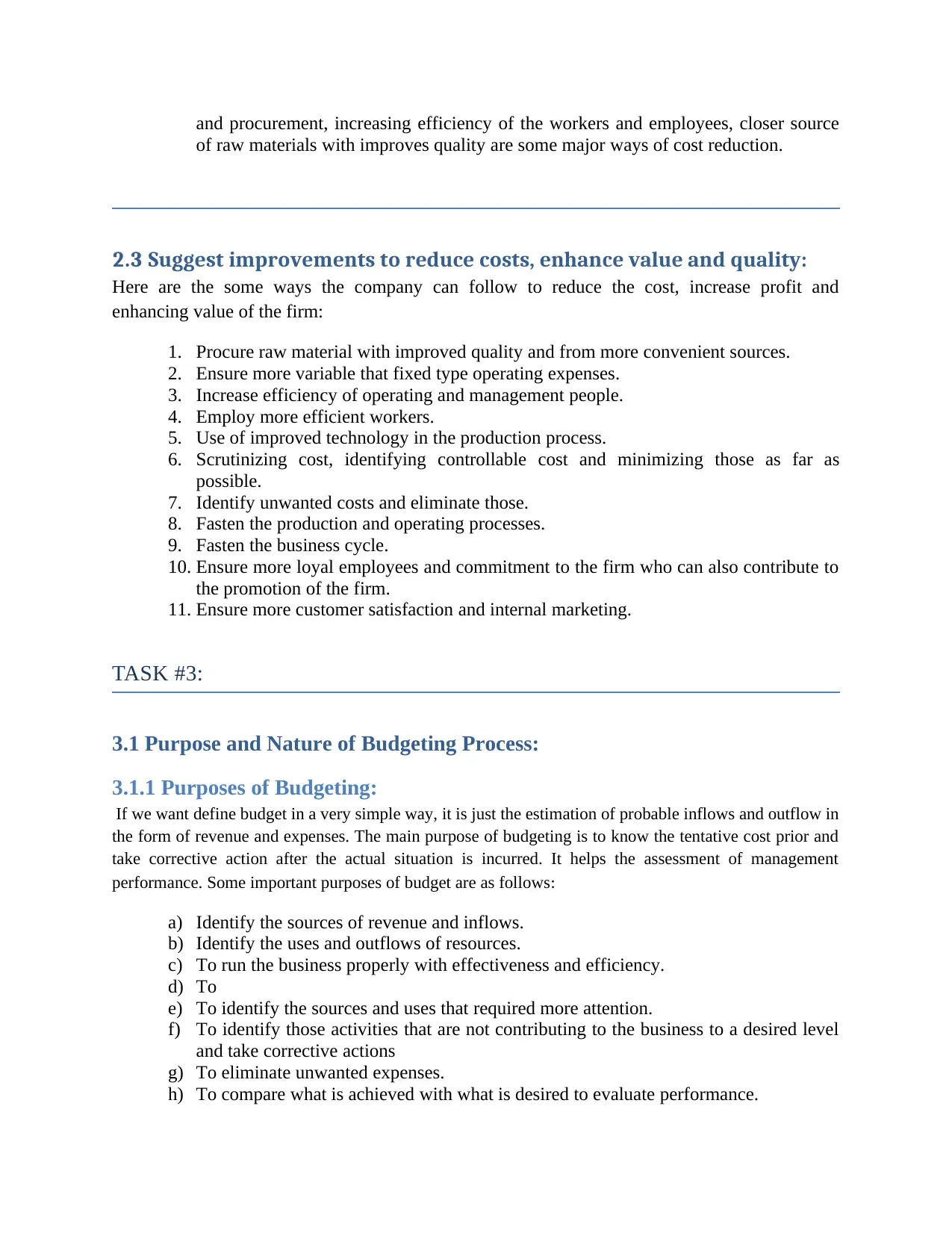
and procurement, increasing efficiency of the workers and employees, closer source
of raw materials with improves quality are some major ways of cost reduction.
2.3 Suggest improvements to reduce costs, enhance value and quality:
Here are the some ways the company can follow to reduce the cost, increase profit and
enhancing value of the firm:
1. Procure raw material with improved quality and from more convenient sources.
2. Ensure more variable that fixed type operating expenses.
3. Increase efficiency of operating and management people.
4. Employ more efficient workers.
5. Use of improved technology in the production process.
6. Scrutinizing cost, identifying controllable cost and minimizing those as far as
possible.
7. Identify unwanted costs and eliminate those.
8. Fasten the production and operating processes.
9. Fasten the business cycle.
10. Ensure more loyal employees and commitment to the firm who can also contribute to
the promotion of the firm.
11. Ensure more customer satisfaction and internal marketing.
TASK #3:
3.1 Purpose and Nature of Budgeting Process:
3.1.1 Purposes of Budgeting:
If we want define budget in a very simple way, it is just the estimation of probable inflows and outflow in
the form of revenue and expenses. The main purpose of budgeting is to know the tentative cost prior and
take corrective action after the actual situation is incurred. It helps the assessment of management
performance. Some important purposes of budget are as follows:
a) Identify the sources of revenue and inflows.
b) Identify the uses and outflows of resources.
c) To run the business properly with effectiveness and efficiency.
d) To
e) To identify the sources and uses that required more attention.
f) To identify those activities that are not contributing to the business to a desired level
and take corrective actions
g) To eliminate unwanted expenses.
h) To compare what is achieved with what is desired to evaluate performance.
of raw materials with improves quality are some major ways of cost reduction.
2.3 Suggest improvements to reduce costs, enhance value and quality:
Here are the some ways the company can follow to reduce the cost, increase profit and
enhancing value of the firm:
1. Procure raw material with improved quality and from more convenient sources.
2. Ensure more variable that fixed type operating expenses.
3. Increase efficiency of operating and management people.
4. Employ more efficient workers.
5. Use of improved technology in the production process.
6. Scrutinizing cost, identifying controllable cost and minimizing those as far as
possible.
7. Identify unwanted costs and eliminate those.
8. Fasten the production and operating processes.
9. Fasten the business cycle.
10. Ensure more loyal employees and commitment to the firm who can also contribute to
the promotion of the firm.
11. Ensure more customer satisfaction and internal marketing.
TASK #3:
3.1 Purpose and Nature of Budgeting Process:
3.1.1 Purposes of Budgeting:
If we want define budget in a very simple way, it is just the estimation of probable inflows and outflow in
the form of revenue and expenses. The main purpose of budgeting is to know the tentative cost prior and
take corrective action after the actual situation is incurred. It helps the assessment of management
performance. Some important purposes of budget are as follows:
a) Identify the sources of revenue and inflows.
b) Identify the uses and outflows of resources.
c) To run the business properly with effectiveness and efficiency.
d) To
e) To identify the sources and uses that required more attention.
f) To identify those activities that are not contributing to the business to a desired level
and take corrective actions
g) To eliminate unwanted expenses.
h) To compare what is achieved with what is desired to evaluate performance.
Paraphrase This Document
Need a fresh take? Get an instant paraphrase of this document with our AI Paraphraser
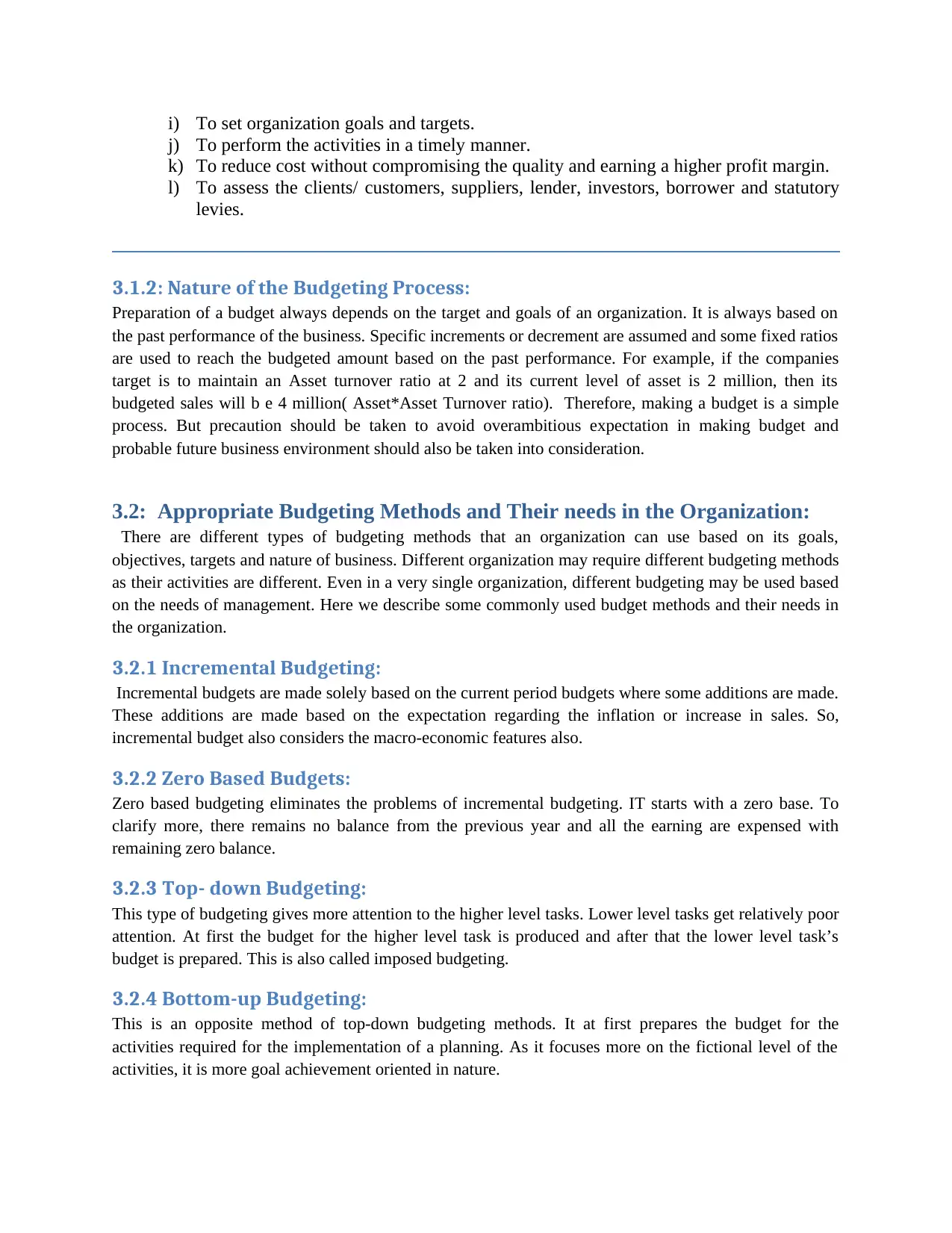
i) To set organization goals and targets.
j) To perform the activities in a timely manner.
k) To reduce cost without compromising the quality and earning a higher profit margin.
l) To assess the clients/ customers, suppliers, lender, investors, borrower and statutory
levies.
3.1.2: Nature of the Budgeting Process:
Preparation of a budget always depends on the target and goals of an organization. It is always based on
the past performance of the business. Specific increments or decrement are assumed and some fixed ratios
are used to reach the budgeted amount based on the past performance. For example, if the companies
target is to maintain an Asset turnover ratio at 2 and its current level of asset is 2 million, then its
budgeted sales will b e 4 million( Asset*Asset Turnover ratio). Therefore, making a budget is a simple
process. But precaution should be taken to avoid overambitious expectation in making budget and
probable future business environment should also be taken into consideration.
3.2: Appropriate Budgeting Methods and Their needs in the Organization:
There are different types of budgeting methods that an organization can use based on its goals,
objectives, targets and nature of business. Different organization may require different budgeting methods
as their activities are different. Even in a very single organization, different budgeting may be used based
on the needs of management. Here we describe some commonly used budget methods and their needs in
the organization.
3.2.1 Incremental Budgeting:
Incremental budgets are made solely based on the current period budgets where some additions are made.
These additions are made based on the expectation regarding the inflation or increase in sales. So,
incremental budget also considers the macro-economic features also.
3.2.2 Zero Based Budgets:
Zero based budgeting eliminates the problems of incremental budgeting. IT starts with a zero base. To
clarify more, there remains no balance from the previous year and all the earning are expensed with
remaining zero balance.
3.2.3 Top- down Budgeting:
This type of budgeting gives more attention to the higher level tasks. Lower level tasks get relatively poor
attention. At first the budget for the higher level task is produced and after that the lower level task’s
budget is prepared. This is also called imposed budgeting.
3.2.4 Bottom-up Budgeting:
This is an opposite method of top-down budgeting methods. It at first prepares the budget for the
activities required for the implementation of a planning. As it focuses more on the fictional level of the
activities, it is more goal achievement oriented in nature.
j) To perform the activities in a timely manner.
k) To reduce cost without compromising the quality and earning a higher profit margin.
l) To assess the clients/ customers, suppliers, lender, investors, borrower and statutory
levies.
3.1.2: Nature of the Budgeting Process:
Preparation of a budget always depends on the target and goals of an organization. It is always based on
the past performance of the business. Specific increments or decrement are assumed and some fixed ratios
are used to reach the budgeted amount based on the past performance. For example, if the companies
target is to maintain an Asset turnover ratio at 2 and its current level of asset is 2 million, then its
budgeted sales will b e 4 million( Asset*Asset Turnover ratio). Therefore, making a budget is a simple
process. But precaution should be taken to avoid overambitious expectation in making budget and
probable future business environment should also be taken into consideration.
3.2: Appropriate Budgeting Methods and Their needs in the Organization:
There are different types of budgeting methods that an organization can use based on its goals,
objectives, targets and nature of business. Different organization may require different budgeting methods
as their activities are different. Even in a very single organization, different budgeting may be used based
on the needs of management. Here we describe some commonly used budget methods and their needs in
the organization.
3.2.1 Incremental Budgeting:
Incremental budgets are made solely based on the current period budgets where some additions are made.
These additions are made based on the expectation regarding the inflation or increase in sales. So,
incremental budget also considers the macro-economic features also.
3.2.2 Zero Based Budgets:
Zero based budgeting eliminates the problems of incremental budgeting. IT starts with a zero base. To
clarify more, there remains no balance from the previous year and all the earning are expensed with
remaining zero balance.
3.2.3 Top- down Budgeting:
This type of budgeting gives more attention to the higher level tasks. Lower level tasks get relatively poor
attention. At first the budget for the higher level task is produced and after that the lower level task’s
budget is prepared. This is also called imposed budgeting.
3.2.4 Bottom-up Budgeting:
This is an opposite method of top-down budgeting methods. It at first prepares the budget for the
activities required for the implementation of a planning. As it focuses more on the fictional level of the
activities, it is more goal achievement oriented in nature.
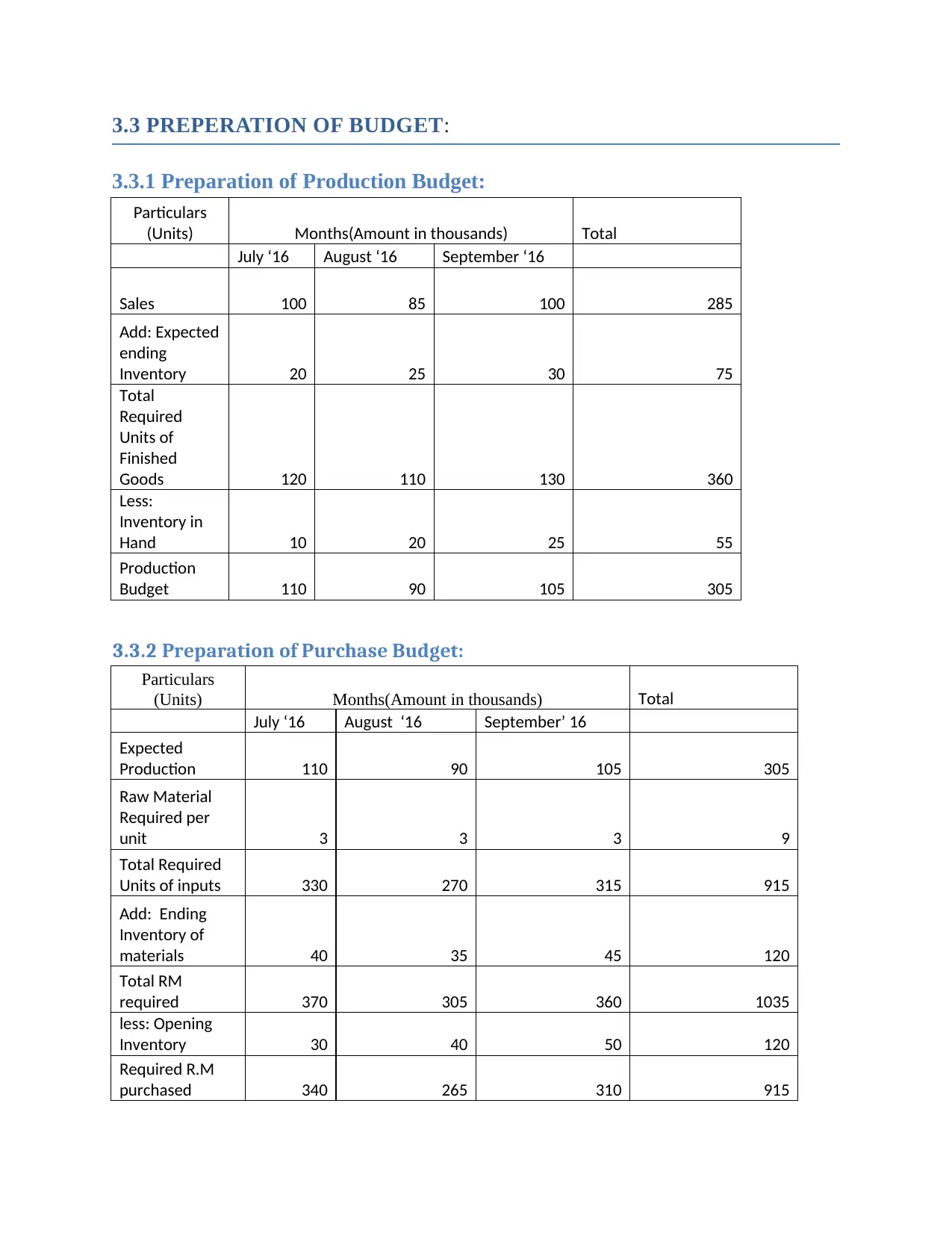
3.3 PREPERATION OF BUDGET:
3.3.1 Preparation of Production Budget:
Particulars
(Units) Months(Amount in thousands) Total
July ‘16 August ‘16 September ‘16
Sales 100 85 100 285
Add: Expected
ending
Inventory 20 25 30 75
Total
Required
Units of
Finished
Goods 120 110 130 360
Less:
Inventory in
Hand 10 20 25 55
Production
Budget 110 90 105 305
3.3.2 Preparation of Purchase Budget:
Particulars
(Units) Months(Amount in thousands) Total
July ‘16 August ‘16 September’ 16
Expected
Production 110 90 105 305
Raw Material
Required per
unit 3 3 3 9
Total Required
Units of inputs 330 270 315 915
Add: Ending
Inventory of
materials 40 35 45 120
Total RM
required 370 305 360 1035
less: Opening
Inventory 30 40 50 120
Required R.M
purchased 340 265 310 915
3.3.1 Preparation of Production Budget:
Particulars
(Units) Months(Amount in thousands) Total
July ‘16 August ‘16 September ‘16
Sales 100 85 100 285
Add: Expected
ending
Inventory 20 25 30 75
Total
Required
Units of
Finished
Goods 120 110 130 360
Less:
Inventory in
Hand 10 20 25 55
Production
Budget 110 90 105 305
3.3.2 Preparation of Purchase Budget:
Particulars
(Units) Months(Amount in thousands) Total
July ‘16 August ‘16 September’ 16
Expected
Production 110 90 105 305
Raw Material
Required per
unit 3 3 3 9
Total Required
Units of inputs 330 270 315 915
Add: Ending
Inventory of
materials 40 35 45 120
Total RM
required 370 305 360 1035
less: Opening
Inventory 30 40 50 120
Required R.M
purchased 340 265 310 915
⊘ This is a preview!⊘
Do you want full access?
Subscribe today to unlock all pages.

Trusted by 1+ million students worldwide
1 out of 21
Related Documents
Your All-in-One AI-Powered Toolkit for Academic Success.
+13062052269
info@desklib.com
Available 24*7 on WhatsApp / Email
![[object Object]](/_next/static/media/star-bottom.7253800d.svg)
Unlock your academic potential
Copyright © 2020–2025 A2Z Services. All Rights Reserved. Developed and managed by ZUCOL.





